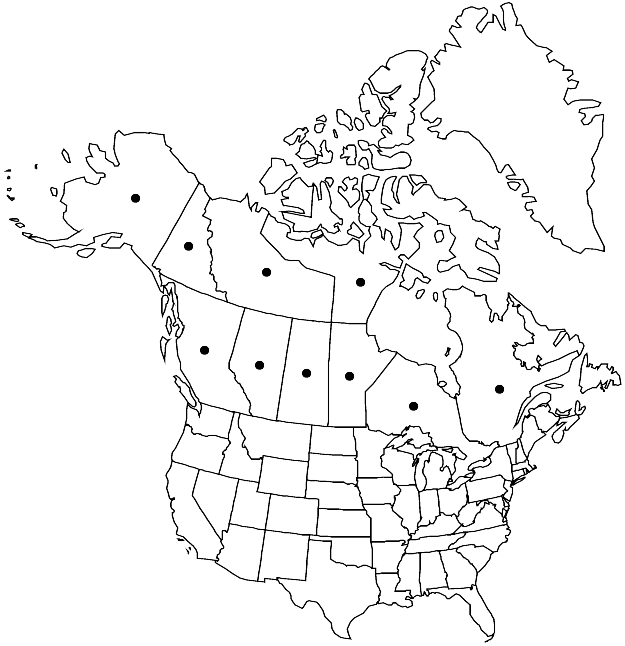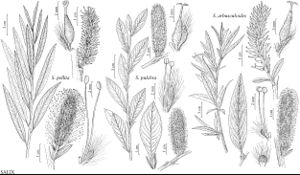Difference between revisions of "Salix arbusculoides"
Monogr. Salicum, 147, plate 8, fig. 81. 1867.
FNA>Volume Importer |
FNA>Volume Importer |
(No difference)
| |
Revision as of 22:52, 16 December 2019
Stems: branches gray-brown to red-brown, not glaucous, glabrous; branchlets red-brown, glabrous or puberulent. Leaves: stipules rudimentary on early ones, apex acute; petiole shallowly grooved adaxially, 3–11 mm, puberulent to glabrescent adaxially; largest medial blade very narrowly elliptic to elliptic, 38–78 × 7–18 mm, base cuneate or convex, margins slightly revolute, serrulate, apex acuminate, acute, or convex, abaxial surface glaucous (sometimes obscured by hairs), sparsely to densely long-silky, hairs (white, sometimes also ferruginous), straight, adaxial highly or slightly glossy, glabrous; proximal blade margins entire; juvenile blade yellowish green, very densely long-silky abaxially, hairs white, sometimes also ferruginous. Catkins flowering as or just before leaves emerge; staminate stout or slender, 17–43 × 5–10 mm, flowering branchlet 0–2.5 mm; pistillate densely to loosely flowered, stout to slender, 20–46 × 6–15 mm, flowering branchlet 0–6 mm; floral bract tawny or brown, 0.8–1.2 mm, apex convex to rounded, abaxially hairy, hairs straight or wavy. Staminate flowers: adaxial nectary oblong, 0.6–0.9 mm; filaments distinct; anthers purple turning yellow, ellipsoid to globose, 0.3–0.6 mm. Pistillate flowers: adaxial nectary oblong or ovate, 0.6–1 mm; ovary pyriform, beak gradually tapering to styles; ovules 16–18 per ovary; styles 0.3–0.5 mm. Capsules 4–6 mm. 2n = 38.
Phenology: Flowering mid May-early Jul.
Habitat: Stream margins, lakeshores, openings in white spruce forests, treed bogs, sedge fens, edges of alpine and arctic tundra
Elevation: 0-2000 m
Distribution

Alta., B.C., Man., N.W.T., Nunavut, Ont., Que., Sask., Yukon, Alaska.
Discussion
Glands on leaf teeth of Salix arbusculoides are sometimes covered with fine crystals of sulphur, calcium, potassium, and silicon (R. Cooper, pers. comm.), indicating that they can function as hydathodes as well as resin glands.
Selected References
None.
